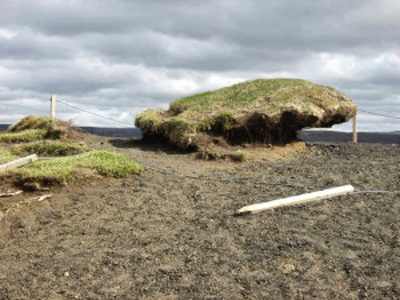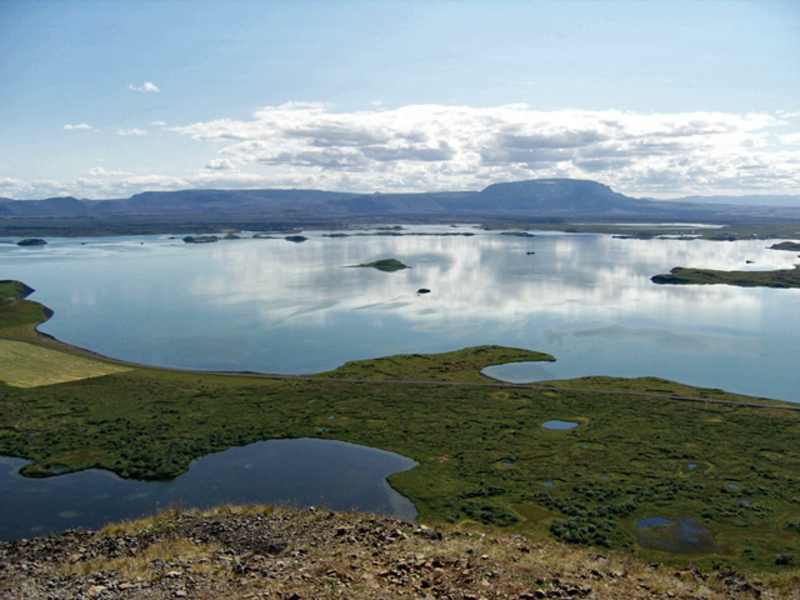“Iceland is the only country in Europe that has been completely destroyed by human activity.”
Such a statement may come as a surprise at first, as Iceland is an extremely popular tourist destination precisely because of its fascinating natural landscapes. But Halldór Laxness (1902–1998), winner of the Nobel Prize for Literature, wrote in his 1970 essay ‘The War on the Land’ that, contrary to what is claimed in tourism advertising, there is no longer any “pristine nature”
to see in Iceland. In fact, Iceland’s present-day appearance is very different from that seen by the first people to reach the previously unsettled land in the second half of the 9th century AD. According to the slendingabók (the ‘Book of Icelanders’, a work on the history of Iceland written around 1125), the country was initially “covered with forest from the mountains to the coast”.
In fact, pollen analyses today show that before the arrival of the people, birch forests covered a good quarter of the country’s surface.
However, the settlers, who mainly came from Norway and the British Isles, saw these forests as obstacles. They wanted to practise an agriculture based on livestock and grain cultivation, just as they were used to at home. The dense forests were therefore cleared to make room for farms, hay meadows, pastures, and fields. Before the arrival of humans, the arctic fox was the only land mammal in Iceland. Horses, cattle, sheep, goats, and pigs came with the settlers. In many places, however, grazing on the sensitive plant cover irreparably affected it. In the 11th century, Icelandic farmers almost completely gave up keeping pigs and goats, which are particularly damaging to vegetation, but by then it was too late. Serious soil erosion had set in. Many farms in the higher interior of the country were abandoned after just a few generations, possibly because the livelihoods of the people there had disappeared along with the topsoil.
Soil erosion has continued to this day and, despite countermeasures introduced in the 20th century, remains Iceland’s most visible environmental problem. While around two-thirds of the land area was covered with vegetation when settlement began, today it is only a quarter and all forests together make up just one percent.
Most areas, especially in the central highlands, are severely affected by erosion. Soil scientists therefore believe that the conditions in Iceland “are among the worst known outside of the earth’s arid zones.”
It is in this context that Laxness’s statement that Iceland was completely destroyed by humans should be understood. In his essay, the Nobel Prize winner primarily criticizes the current environmental degradation. However, he makes it clear that their roots lie in the time of the conquest. Because even the first settlers were characterized by a materialistic ruthlessness towards the natural environment, and even in the sagas written in the 13th century it can be seen that their authors were alien to any aesthetic appreciation of landscape: “These people had no understanding for the beauty of the land.”
Laxness thus took a fundamentally opposite position to the conventional picture of the time from the Conquest to the end of the Icelandic ‘Free State’ in 1264. In the national collective memory, this period is considered a golden age, characterized by heroism, independence, material prosperity and a high culture that made a unique contribution to world literature in the form of the Sagas and Eddas. The fact that the same culture is said to have seriously damaged the country’s ecosystems does not fit into this picture.
For a long time, but significantly increased since the 1990s, there have been attempts in Iceland to find references to an aesthetic appreciation of nature in Old Icelandic literature.
One of the most frequently cited examples in this context is an episode from the Njáls saga, which describes how the heroic Gunnar, after his ostracism, sets out to leave Iceland for three years. However, when he looks back at his farm, he says: “The mountain slope is so beautiful that it has never seemed so beautiful to me before, the bright yellow fields and the mowed house meadow. I will ride home and not go anywhere.”
Gunnar does stay and is subsequently killed by his enemies. Behind the attempt to interpret this and similar text passages as an expression of a purely aesthetic view of the landscape, detached from any utility aspects, stands, on the one hand, the described nationalistic view of history. Francesco Petrarch’s description of his ascent of Mont Ventoux in 1336 was long regarded as the earliest possible evidence of such a perception of nature. If such a perspective existed in a text such as the Njáls saga, which was probably written in the 13th century (which, in turn, contains events from the 10th century and thus from the Viking Age), from a nationalist point of view, this would once again prove the special position of Icelandic culture.
On the other hand, the increased efforts to extract an aesthetic sense of nature from the old Icelandic literature must be seen against the background of social conflicts about the construction of large hydroelectric power plants for the purpose of locating heavy industry in Iceland. Even Laxness opposed such projects in his essay.
From the 1990s on, however, the construction of large dams was accelerated even more than in previous decades. The resistance of the now rapidly growing Icelandic environmental movement was not only directed against the ecological consequences (e.g., the loss of vegetation due to reservoirs), but also against the aesthetic changes in the landscape, for example, due to high-voltage lines running from the power plants, which are mostly located in the highlands, to the industrial companies built near the coast.
The implicit basic assumption of the opponents of this industrial policy, who refer to the Old Icelandic literature, is firstly that an aesthetic appreciation of the beauty of the landscape would motivate a commitment to its protection, and secondly that it would be relevant for current actions if such an appreciation already existed and had been cared for by the ancestors in the Viking Age and the Middle Ages.

But before the collapse of the Icelandic banking system in 2008, the proponents of neoliberal, strongly market-oriented economic policy often justified their position with reference to the past. Ruthless individualism, which they believed to be embodied by the Vikings of the conquest period, they interpreted as a necessary foundation of economic gain and thus as a positive trait – most visible in the proud labelling of successful Icelandic businessmen as ‘expansion Vikings’ (trásarvkingar).
Thus, the Viking Age and mediaeval past—reconstructed by resorting to Old Icelandic literature—also implicitly served to legitimise current actions: the ancestors would not have let something immaterial like ‘beauty’ prevent them from using the natural resources of the country economically, and therefore modern-day Icelanders should not do it either.
The proof or refutation of an aesthetic appreciation of landscape in the sagas thus has a not inconsiderable relevance for the contemporary environmental discussion in Iceland.It is therefore relatively undisputed that research into earlier epochs can contribute a lot to a better understanding of current environmental problems. But does it really make sense to put the main focus on the question of whether the landscape was already perceived as ‘beautiful’ in pre-modern times? Regardless of the answer to this question, it is clear that enormous ecological changes have taken place in Iceland since the beginning of human settlement. It was not just soil erosion that posed significant challenges for Icelandic society as early as the Middle Ages.
The climate also changed: while it was relatively warm in the first few centuries after settlement, a cooling trend, associated with considerable fluctuations, evidently began by the 14th century, and at the latest, increasing erosion has caused significant problems for the almost exclusively agricultural Icelandic society. In addition, there were environmental risks associated with volcanism in Iceland.
In the numerous volcanic eruptions documented since the beginning of settlement, the populated area was rarely directly affected, for example by lava flows, but volcanic ash spreading over large areas could damage the vegetation and have a toxic effect on livestock, which in turn threatened human food supplies.
Iceland offers exceptional opportunities to explore how a pre-modern society dealt with such environmental changes and risks. Because not only do palaeoecological studies and archaeological excavations now contribute more and more to our knowledge of past environmental conditions, but they also provide a wealth of new data on the human diet.
Iceland’s written culture, which is unique in mediaeval Europe, also left behind an enormous amount of texts that can be compared to the other sources. This includes not only historiographical texts in the narrower sense, such as documents and annals, but also and especially the sagas, which in their entirety describe the time from the first settlement of the country to the middle of the 14th century. They provide detailed insights into, for example, agricultural practises, the use of natural resources, and human perceptions of environmental conditions and environmental risks.
They don’t necessarily provide ‘realistic’ descriptions; after all, these are literary texts that are extremely creative and selective in describing the non-literary world. However, in relation to all the other types of sources, they still contribute significantly to our knowledge of human-environmental dynamics in premodern Iceland.Herein lies the real value of the sagas for today’s environmental discussion. In a time of dwindling resources, global climate change, and rapid ecosystem change, it can be highly relevant to learn whether—and if so, how—earlier societies managed to respond appropriately to ecological challenges.
And some of the sources do point to success stories. Because regardless of whether the mediaeval Icelanders appreciated the aesthetic value of their island’s nature, they by no means just exploited and destroyed it. In this way, numerous forests were preserved well into modern times, with continuous economic use.
At Lake Mvatn in North Iceland, it has been proven that there have been populations of waterfowl for more than 1100 years—from the Viking Age to the present day—that have been managed sustainably. Even in times of need, only enough eggs were removed from the nests to maintain the overall bird population as an important food resource.
The sagas and other sources from pre-modern Iceland will not provide us with a panacea for solving the global environmental problems of our own time. But exploring them in an interdisciplinary way can still help us learn from both the mistakes and the successes of the past. Laxness was evidently also firmly convinced that this was possible in principle. With his essay, which was published 45 years ago, the Nobel Prize winner became his country’s first literary environmental activist.

